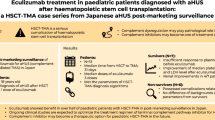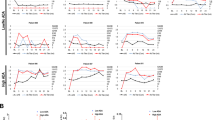Abstract
Malignant infantile osteopetrosis (MIOP) is a rare hereditary disorder of osteoclast function, which can be reversed by hematopoietic stem cell transplantation (SCT). We observed a high incidence of hepatic veno-occlusive disease (VOD) in transplanted patients and explored the prevention of this complication by using defibrotide (DF) as a prophylaxis. Twenty children with MIOP were consecutively transplanted in our center between 1996 and 2005. Eleven of these patients were transplanted between 1996 and 2001 and experienced an overall incidence of VOD of 63.6% (7/11). VOD was severe in three patients and one patient succumbed to VOD-related multi-organ failure. Owing to this very high incidence of VOD, DF prophylaxis was initiated in nine patients consecutively transplanted between 2001 and 2005. In this group, only one patient (11.1%) was diagnosed with moderate VOD. We report here a very high risk in patients with MIOP to develop VOD after transplantation. Prophylactic DF was implemented in our current transplant protocol and reduced the VOD rate significantly in this high-risk population.
This is a preview of subscription content, access via your institution
Access options
Subscribe to this journal
Receive 12 print issues and online access
$259.00 per year
only $21.58 per issue
Buy this article
- Purchase on Springer Link
- Instant access to full article PDF
Prices may be subject to local taxes which are calculated during checkout

Similar content being viewed by others
References
Fasth A, Porras O . Human malignant osteopetrosis: pathophysiology, management and the role of bone marrow transplantation. Pediatr Transplant 1999; 3 (Suppl 1): 102–107.
Frattini A, Orchard PJ, Sobacchi C, Giliani S, Abinun M, Mattsson JP et al. Defects in TCIRG1 subunit of the vacuolar proton pump are responsible for a subset of human autosomal recessive osteopetrosis. Nat Genet 2000; 25: 343–346.
Frattini A, Pangrazio A, Susani L, Sobacchi C, Mirolo M, Abinun M et al. Chloride channel ClCN7 mutations are responsible for severe recessive, dominant, and intermediate osteopetrosis. J Bone Miner Res 2003; 18: 1740–1747.
Sobacchi C, Frattini A, Orchard P, Porras O, Tezcan I, Andolina M et al. The mutational spectrum of human malignant autosomal recessive osteopetrosis. Hum Mol Genet 2001; 10: 1767–1773.
Kornak U, Kasper D, Bosl MR, Kaiser E, Schweizer M, Schulz A et al. Loss of the ClC-7 chloride channel leads to osteopetrosis in mice and man. Cell 2001; 104: 205–215.
Cleiren E, Benichou O, Van Hul E, Gram J, Bollerslev J, Singer FR et al. Albers–Schonberg disease (autosomal dominant osteopetrosis, type II) results from mutations in the ClCN7 chloride channel gene. Hum Mol Genet 2001; 10: 2861–2867.
Campos-Xavier AB, Saraiva JM, Ribeiro LM, Munnich A, Cormier-Daire V . Chloride channel 7 (CLCN7) gene mutations in intermediate autosomal recessive osteopetrosis. Hum Genet 2003; 112: 186–189.
Coccia PF, Krivit W, Cervenka J, Clawson C, Kersey JH, Kim TH et al. Successful bone-marrow transplantation for infantile malignant osteopetrosis. N Engl J Med 1980; 302: 701–708.
Driessen GJ, Gerritsen EJ, Fischer A, Fasth A, Hop WC, Veys P et al. Long-term outcome of haematopoietic stem cell transplantation in autosomal recessive osteopetrosis: an EBMT report. Bone Marrow Transplant 2003; 32: 657–663.
Schulz AS, Classen CF, Mihatsch WA, Sigl-Kraetzig M, Wiesneth M, Debatin KM et al. HLA-haploidentical blood progenitor cell transplantation in osteopetrosis. Blood 2002; 99: 3458–3460.
Steward CG, Pellier I, Mahajan A, Ashworth MT, Stuart AG, Fasth A et al. Severe pulmonary hypertension: a frequent complication of stem cell transplantation for malignant infantile osteopetrosis. Br J Haematol 2004; 124: 63–71.
McDonald GB, Hinds MS, Fisher LD, Schoch HG, Wolford JL, Banaji M et al. Veno-occlusive disease of the liver and multiorgan failure after bone marrow transplantation: a cohort study of 355 patients. Ann Intern Med 1993; 118: 255–267.
Carreras E, Bertz H, Arcese W, Vernant JP, Tomas JF, Hagglund H et al. Incidence and outcome of hepatic veno-occlusive disease after blood or marrow transplantation: a prospective cohort study of the European Group for Blood and Marrow Transplantation. European Group for Blood and Marrow Transplantation Chronic Leukemia Working Party. Blood 1998; 92: 3599–3604.
Palmer KJ, Goa KL . Defibrotide. A review of its pharmacodynamic and pharmacokinetic properties, and therapeutic use in vascular disorders. Drugs 1993; 45: 259–294.
Eissner G, Multhoff G, Gerbitz A, Kirchner S, Bauer S, Haffner S et al. Fludarabine induces apoptosis, activation, and allogenicity in human endothelial and epithelial cells: protective effect of defibrotide. Blood 2002; 100: 334–340.
Falanga A, Marchetti M, Vignoli A, Barbui T . Defibrotide (DF) modulates tissue factor expression by microvascular endothelial cells. Blood 1999; 94: 146a.
Falanga A, Marchetti M, Vignoli A, Barbui T . Impact of defibrotide on the fibrinolytic and procoagulant properties of endothelial cells from macro- and micro-vessels. Blood 2000; 96: 53a.
Falanga A, Vignoli A, Marchetti M, Barbui T . Defibrotide reduces procoagulant activity and increases fibrinolytic properties of endothelial cells. Leukemia 2003; 17: 1636–1642.
Chopra R, Eaton JD, Grassi A, Potter M, Shaw B, Salat C et al. Defibrotide for the treatment of hepatic veno-occlusive disease: results of the European compassionate-use study. Br J Haematol 2000; 111: 1122–1129.
Richardson PG, Elias AD, Krishnan A, Wheeler C, Nath R, Hoppensteadt D et al. Treatment of severe veno-occlusive disease with defibrotide: compassionate use results in response without significant toxicity in a high-risk population. Blood 1998; 92: 737–744.
Richardson PG, Murakami C, Jin Z, Warren DL, Momtaz P, Hoppensteadt D et al. Multi-institutional use of defibrotide in 88 patients post stem cell transplant with severe veno-occlusive disease and multi-system organ failure; response without significant toxicity in a high risk population and factors predictive of outcome. Blood 2002; 100: 4337–4343.
Richardson PG, Soiffer R, Antin JH, Vredenburgh J, Kurtzberg J, Martin PL et al. Defibrotide (DF) appears effective and safe in a phase II, randomized study of patients (pts) with severe veno-occlusive disease (VOD) and multi-system organ failure (MOF) post stem cell transplantation (SCT). Blood 2002; 100: 112a.
Corbacioglu S, Greil J, Peters C, Wulffraat N, Laws HJ, Dilloo D et al. Defibrotide in the treatment of children with veno-occlusive disease (VOD): a retrospective multicentre study demonstrates therapeutic efficacy upon early intervention. Bone Marrow Transplant 2004; 33: 189–195.
Jones RJ, Lee KS, Beschorner WE, Vogel VG, Grochow LB, Braine HG et al. Venoocclusive disease of the liver following bone marrow transplantation. Transplantation 1987; 44: 778–783.
Carreras E, Granena A, Navasa M, Bruguera M, Marco V, Sierra J et al. On the reliability of clinical criteria for the diagnosis of hepatic veno-occlusive disease. Ann Hematol 1993; 66: 77–80.
Chalandon Y, Roosnek E, Mermillod B, Newton A, Ozsahin H, Wacker P et al. Prevention of veno-occlusive disease with defibrotide after allogeneic stem cell transplantation. Biol Blood Marrow Transplant 2004; 10: 347–354.
Versluys B, Bhattacharaya R, Steward C, Cornish J, Oakhill A, Goulden N . Prophylaxis with defibrotide prevents veno-occlusive disease in stem cell transplantation after gemtuzumab ozogamicin exposure. Blood 2004; 103: 1968.
Barker CC, Butzner JD, Anderson RA, Brant R, Sauve RS . Incidence, survival and risk factors for the development of veno-occlusive disease in pediatric hematopoietic stem cell transplant recipients. Bone Marrow Transplant 2003; 32: 79–87.
Cesaro S, Pillon M, Talenti E, Toffolutti T, Calore E, Tridello G et al. A prospective survey on incidence, risk factors and therapy of hepatic veno-occlusive disease in children after hematopoietic stem cell transplantation. Haematologica 2005; 90: 1396–1404.
Przepiorka D, Khouri I, Thall P, Mehra R, Lee MS, Ippoliti C et al. Thiotepa, busulfan and cyclophosphamide as a preparative regimen for allogeneic transplantation for advanced chronic myelogenous leukemia. Bone Marrow Transplant 1999; 23: 977–981.
Lee JL, Gooley T, Bensinger W, Schiffman K, McDonald GB . Veno-occlusive disease of the liver after busulfan, melphalan, and thiotepa conditioning therapy: incidence, risk factors, and outcome. Biol Blood Marrow Transplant 1999; 5: 306–315.
Worth L, Tran H, Petropoulos D, Culbert S, Mullen C, Roberts W et al. Hematopoietic stem cell transplantation for childhood myeloid malignancies after high-dose thiotepa, busulfan and cyclophosphamide. Bone Marrow Transplant 1999; 24: 947–952.
Fagioli F, Biasin E, Mastrodicasa L, Sandri A, Ferrero I, Berger M et al. High-dose thiotepa and etoposide in children with poor-prognosis brain tumors. Cancer 2004; 100: 2215–2221.
de Jonge ME, Huitema AD, Beijnen JH, Rodenhuis S . High exposures to bioactivated cyclophosphamide are related to the occurrence of veno-occlusive disease of the liver following high-dose chemotherapy. Br J Cancer 2006; 94: 1226–1230.
Author information
Authors and Affiliations
Corresponding author
Rights and permissions
About this article
Cite this article
Corbacioglu, S., Hönig, M., Lahr, G. et al. Stem cell transplantation in children with infantile osteopetrosis is associated with a high incidence of VOD, which could be prevented with defibrotide. Bone Marrow Transplant 38, 547–553 (2006). https://doi.org/10.1038/sj.bmt.1705485
Received:
Accepted:
Published:
Issue Date:
DOI: https://doi.org/10.1038/sj.bmt.1705485
Keywords
This article is cited by
-
A Systematic Review and Meta-Analysis of Studies of Defibrotide Prophylaxis for Veno-Occlusive Disease/Sinusoidal Obstruction Syndrome
Clinical Drug Investigation (2022)
-
Improved detection of sinusoidal obstructive syndrome using pediatric–AYA diagnostic criteria and severity grading
Bone Marrow Transplantation (2021)
-
Assessment of the proposed EBMT pediatric criteria for diagnosis and severity grading of sinusoidal obstruction syndrome
Bone Marrow Transplantation (2019)
-
Systematic review of defibrotide studies in the treatment of veno-occlusive disease/sinusoidal obstruction syndrome (VOD/SOS)
Bone Marrow Transplantation (2019)
-
Diagnosis and severity criteria for sinusoidal obstruction syndrome/veno-occlusive disease in pediatric patients: a new classification from the European society for blood and marrow transplantation
Bone Marrow Transplantation (2018)



